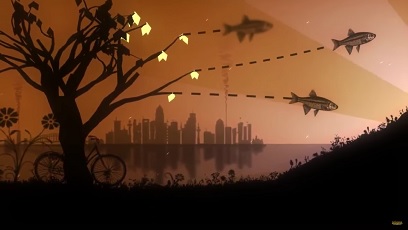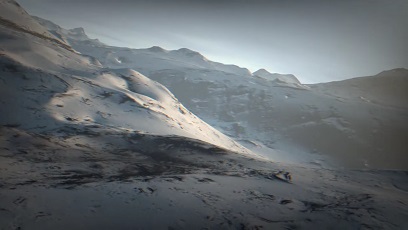
The Demoscene

An article that summarizes the development of the PC demoscene from its beginnings in 1991 to the year 2015. Primarily for people who have not heard about the demoscene yet, to learn about what you have missed in your life so far.
Written by Claus Volko
Vienna, Austria, Europe
Contact: cdvolko (at) gmail (dot) com
Homepage: www.cdvolko.net
The demoscene is an international computer arts community that is hardly known to anybody except true computer freaks. These people meet at so-called demoparties on a regular basis, where competitions ("compos") for the best demo, the best intro, the best hand-drawn picture, the best musical piece, the best computer game etc. are held. These people are highly creative and technically skilled.
What is a demo? Basically, an executable file that, when run, displays a graphical effects show accompanied with music, often in 3D. An intro is the same thing with a size limit of 64 or even 4 kbyte of code and data (yes, you've read correctly). These demos and intros ("productions") are usually developed in programming languages such as C++ and Assembler. The demoscene also used to have its own magazines, the so-called diskmags. In fact Genycs Magazine is similar to a demoscene diskmag, it is based on the same technical principles, i. e. a hard-coded engine with a graphical user interface and a built-in music player.
In this article I would like to introduce some of the most notable demos, intros and diskmags from five periods of PC demo scene life to you. It is intended to be a quick overview and of course it is far from completion. There have been many great demos, intros and diskmags that are not mentioned here. Note that there has also been a lot of demoscene activity on other platforms such as Commodore 64 (where it originally had its roots), Commodore Amiga and Atari ST.
Demosceners: Please do not be angry or sad if one of your productions is not listed in this article although you think it is significant.
This article may be highly interesting for people who have not become acquainted with the scene so far or are new to the scene, but I guess also experienced sceners might enjoy reading it. All of the productions that are mentioned in this article can be downloaded from the scene.org servers. I have also included links to videos at YouTube where you can watch the demos and intros even if your configuration does not match the system requirements.
.
1991 - 1995
Demos: Unreal, Second Reality, Crystal Dream II, Stars, Dope, No!
Intros: Timeless, Nation Zero, Cyboman 2, Airframe
Diskmags: Imphobia 1-11, Scenial 1-4, Daskmig 1-8
Back in the early days, demo coding required knowledge of programming languages, technical knowledge about the video card, good knowledge of trigonometry and analytical geometry (the stuff you usually learn at high school in grades 10 and 11) and great expertise in code optimization, as the power of the machines were still rather limited. Demos were usually coded using x86 Assembler, Turbo Pascal or C. Often several of these programming languages were combined - the main program was written in Pascal or C and critical routines were written in Inline Assembler to achieve better performance. All of these demos worked under MS-DOS. For the music, trackers were used, such as Fast Tracker 2 or Impulse Tracker.
The most notable diskmag in this early period was Imphobia 1-11. Huge issues stuffed with tons of articles can give you a good overview of the debates from the beginning of the PC demoscene. Other notable diskmags from this period were Scenial 1-4 and Daskmig 1-8.
.
1996 - 2000
Demos: The Fulcrum, State Of Mind, 303, Square, Sunflower, Wonder, VIP2, MHC
Intros: fr-08: .the .product, Heaven Seven, Discloned, you am i you am the robot, Stash, Jizz, Omniscent, Mesha, Please The Cookie Thing, Bakkslide 7, hplus
Diskmags: Imphobia 12, Hugi 11-21, Fleur 1-3, Shine 1-8
The demoscene slowly made the transition to Windows, employing OpenGL and DirectX to achieve a good performance of the graphic routines. With time, MP3 replaced tracking formats such as XM and IT as the standard music format, and composers increasingly used streaming software for music production.
This was also the time when 64k intros became strong. With their eighth production, fr-08: .the .product, Farbrausch introduced procedural modelling. The textures of this 64k intro were created by the program in real time. Uncompressed they would have occupied more than 1 GB of disk space.
In 1996 the last issue of Imphobia, Imphobia 12, was released. Apart from that, the most notable diskmag from this period was Hugi 11-21. It tried to continue the style of Imphobia. Other notable diskmags were Fleur 1-3 and Shine 1-8.
.
2001 - 2005
Demos: Iconoclast, Variform, The Popular Demo, 195/95
Intros: Kings of the Playground, Candytron, Poem to a Horse, Project Genesis,
A Place Called Universe
Diskmags: Pain 46-57, Hugi 22-31
A new trend to be observed was that demo creators built demotools which executed the demos as scripts instead of coding everything directly in C or Assembler. Again Farbrausch were the pioneers with their demo tool Werkkzeug.
Although Variform placed only second in the competition where it was released, it became an instant classic in the demoscene community because many people felt that it transported the right mood.
The Hungarian groups Umlaut Design and Digital Dynamite teamed up and formed Conspiracy, the group that continously surprised the scene with its great 64k intros.
The formerly Swiss scene diskmag Pain became international and the leader of PC diskmags. Pain 46-57 was the most notable diskmag of this period. The Hugi issues released in these years were rather weak in comparison.


.
2006 - 2010
Demos: Lifeforce, Debris, Masagin, 828, Rove, Magellan, Happiness is Around the Bend, Agenda Circling Forth
Intros: Chaos Theory, Malewitsch, Elevated, Frameskool
Diskmags: Zine 12-14, Hugi 32-36, Pain 58-59
Farbrausch, Conspiracy, Still and other groups released versions of their demotools to the public. This led to an increase of demos which were made using such tools.
With Lifeforce and Happiness is Around the Bend, the originally Greek demogroup ASD (Andromeda Software Development) released two of their greatest works, thus continuing a tradition they established with their demo Iconoclast in 2005.
The most notable diskmags in this period were Zine 12-14 and Hugi 32-36. Pain stopped issuing after 2007. Although only three issues of Zine were released, all of them were very good and serve to give an overview of scene activities. In the Hugi staff, Magic teamed up as a co-editor and content manager, and he was responsible for the newly regained glory of the Hugi Magazine.
.
2011 - 2015
Demos: Monolith, We Stand Divided, Coronoid, Intrinsic Gravity
Intros: The Timeless, Gaia Machina, Uncovering Static
Diskmags: Hugi 37-38
The groups Cocoon and Still came strong in this recent period.
While these years saw a lot of great demos and intros, the only notable (and almost only of all) diskmag released in this period was Hugi 37-38. Pain and Zine had stopped issuing and apart from Hugi, only minor magazines were released.
I hope you have enjoyed this article and it has whetted your appetite for demos - maybe you also want to get active in the demoscene yourself. If any demo has caught your interest, just click the name of the demo and your web browser will open and bring you to the related YouTube video.
Claus Volko